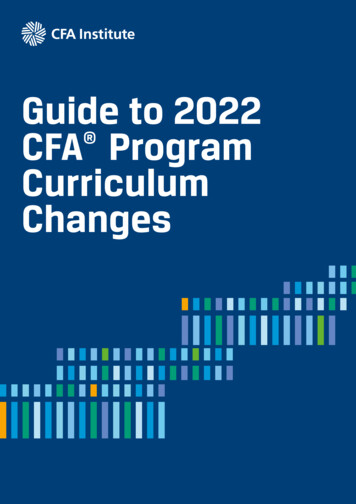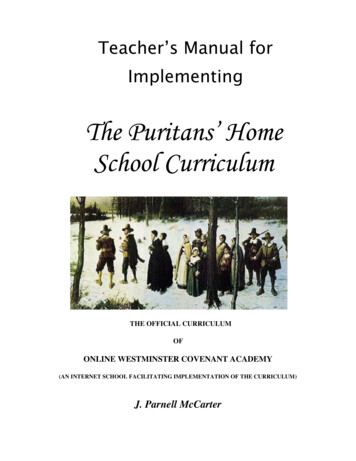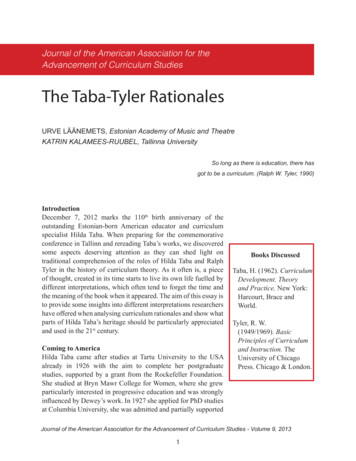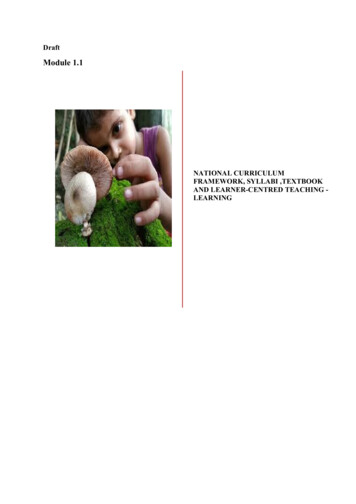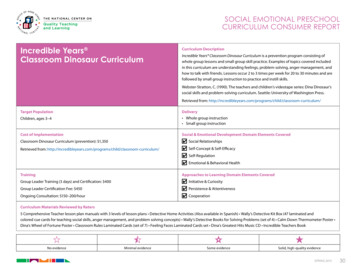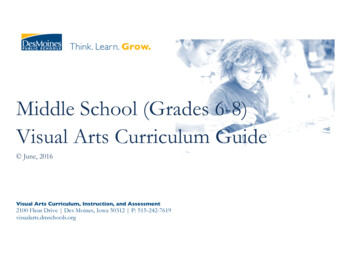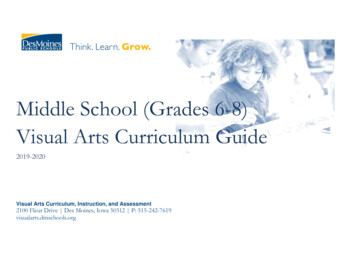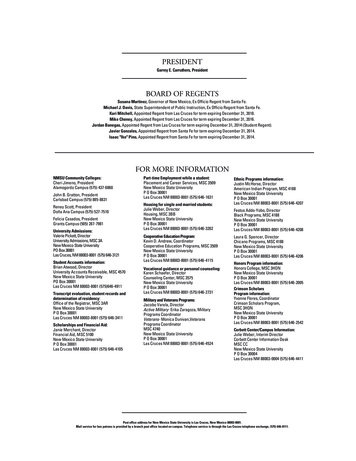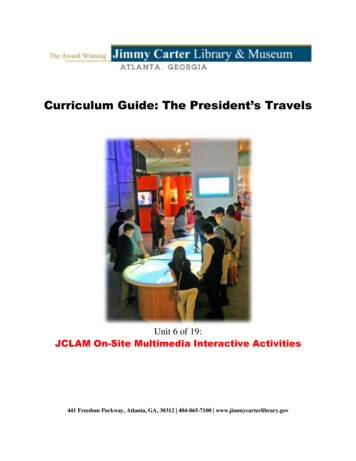
Transcription
Curriculum Guide: The President’s TravelsUnit 6 of 19:JCLAM On-Site Multimedia Interactive Activities441 Freedom Parkway, Atlanta, GA, 30312 404-865-7100 www.jimmycarterlibrary.gov
Jimmy Carter Library and MuseumTaking ActionWatch the video about the Carter CenterIn the Post Presidency section of the JimmyCarter Library and Museum, students will see avideo that details the work of Jimmy andRosalynn Carter through The Carter Center.The Carter Center has been involved incountries around the world including Ghana,North Korea, Cuba, Ethiopia, and Norway.Introductory activityMap activity of countriesmentioned in the videoPage 2 - 3Students will also be able to see differentpresents and artifacts from the variouscountries that the Carters have visited. Thereare airplane chairs and space in front of thescreen for students to gather as they completethe video viewing guide.Video ViewingActivityQuestions for students toanswer while viewing the videoPage 4 - 5Post field tripactivityStudentswill create a travelbrochure about countries fromthe videoPage 6
JJimmy Carter Library and MuseumTheCarters inAfricaStudent Activity #1: Mapping TheCarter’s travels mentioned in thevideoStudents will label a world map of all of the countriesmentioned in the Taking Action video that they will viewwhen they come to the Jimmy Carter Library and Museum.Students will color each country and then label itaccordingly. World maps can be downloaded off a numbera websites including http://www.freeworldmaps.net/.Students should color and label the followingcountries:GhanaNorth KoreaCubaEthiopiaNorway
JJimmy Carter Library and ian.gif
JJimmy Carter Library and MuseumTaking Action Video QuestionsWhile watching the video, answer the following questions:1. When the Carters come to the village where the Guinea Worm had been eradicated,how do the villagers respond to them?2. What types of things did the typical villages that had Guinea worm not have?3. What was the purpose of the trip to North Korea?4. President Carter says the Kim Il Sung, the leader of North Korea at the time, was acombination of what two people for the people of North Korea?5. Was the trip to North Korea successful?6. Did Fidel Castro want the Carters to come to Cuba?7. In what language did Jimmy Carter give his speech to the Cuban people?8. What was the one request that Castro had of President Carter while he was in Cuba?9. In Ethiopia, what has the Carter Center done to eliminate trachoma?10. In Norway, what person sang “Georgia on my Mind” and was a favorite of JimmyCarter?
JJimmy Carter Library and MuseumTaking Action Video Questions— Answer KEY1. dancing and celebrating, they gave robes to the Carters2. running water, pumps3. The purpose of the trip to North Korea was actually to prevent a war4. According to President Carter, Kim Il Sung, for the North Koreanpeople, was a combination of Jesus Christ and George Washington5. They negotiated successfully to end their production of nuclearweapons. “So we prevented a war, and we ended, at least for the timebeing, North Korea’s commitment to a nuclear capability”. But not all ofthe agreements that they negotiated on that trip were carried out6. Castro was very eager for them to come.7. Carter spoke in Spanish.8. “I want you and me to walk out on the baseball field with no security.I want the world to see that the former President of United States iscompletely safe among 50,000 Cubans.”9. Program to get rid of the flies, e.g. building privies (outdoor toilets)10. Willie Nelson
JJimmy Carter Library and MuseumStudent Activity #3Creating a travel brochure for selected countriesAfter visiting the Jimmy CarterLibrary and Museum, students will createa travel brochure about one of the placesthat the video “Taking Action” discussed.Have students choose one of thefollowing countries in order to create atravel brochure: Ghana, North Korea,Cuba, Ethiopia, and Norway.In the travel brochure, studentsshould create six panels of informationfor their country. The six panels shouldconsist of a Title page, physicalgeography, political geography, Culturegeography, Carter Center programs, andCurrent news. Students can create thebrochure on the computer using MicrosoftOffice programs such as Word or Publisher.Students can research information froma variety of websites including the CIAWorld Fact world-factbook/) and the CarterCenter country .html.
JJimmy Carter Library and MuseumGeorgia Performance StandardsGrade Two SS2H1 (a.)The student will read about and describe the lives of historical figures in Georgia history.a.Identify the contributions made by these historic figures: Jimmy Carter (leadership and humanrights).Grade Two SS2CG3The student will give examples of how the historical figures under study demonstrate the positivecitizenship traits of honesty, dependability, liberty, trustworthiness, honor, civility, goodsportsmanship, patience, and compassion.Grade Six SS6G1The student will locate selected features of Latin America and the Caribbean.b. Locate on a world and regional political-physical map the countries of Cuba.Grade Eight SS8H12 (B.)The student will explain the importance of significant social, economic, and political developments inGeorgia since 1970.b. Describe the role of Jimmy Carter in Georgia as state senator, governor, president, and pastpresident.Web ResourcesMap websiteshttp://www.freeworldmaps.net/For more information on the Carter’s travels, see Beyond the White House: Waging Peace, FightingDisease, Building Hope, by Jimmy Carter at 1.aspxThe Carter Centerhttp://www.cartercenter.org/index.htmlPeace mlHealth tmlJimmy Carter Library and Museumhttp://www.jimmycarterlibrary.gov/Country -world-factbook/)
The Interactive Map TableA one of a kind interactive experienceGhanaOur INTERACTIVE MAP TABLE is able toaccommodate up to 18 users at once. Thisstate-of-the-art display utilizes sixworkstations, a flat-panel display monitor,overhead projection system, and customizableeducational hardware and software to teachmulti-disciplinary content: from geography,science, and history, to health & welfare, andhuman and political rights issues! You get totravel on your own airplane, virtually collectstamps of visited countries in your passport,and even email souvenirs and informationabout your travels to yourself and others.
Georgia Performance StandardsSSWG1 The student will explain the physical aspects of geography.a. Describe the concept of place by explaining how physical characteristics such as landforms,bodies of water, climate, soils, natural vegetation, and animal life are used to describea place.SSWG2 The student will explain the cultural aspects of geography.a. Describe the concept of place by explaining how the culture of a region is a product of theregion’s physical characteristics.b. Explain how cultural characteristics of a place can be used to describe a place.c. Analyze how physical factors such as mountains, climate, and bodies of water interact withthe people of a region to produce a distinctive culture.SSWG4 The student will describe the interaction of physical and human systems that haveshaped contemporary Sub-Saharan Africa.a. Describe the location of major physical features and their impact on Sub-Saharan Africa.b. Describe the major climates of Sub-Saharan Africa and how they have affected thedevelopment of Sub-Saharan Africa.SSWG7 The student will describe the interaction of physical and human systems that haveshaped contemporary Latin America.a. Explain why the region is known as Latin America; include cultural reasons.b. Describe the location of major physical features and their impact on Latin America.c. Describe the major climates of Latin America and how they have affected LatinAmerica.Websites for research on the Carter Center programs and ites for research on the-world-factbook/http://www.atlapedia.com/
Students will create a graphic organizer (see chart below) that will give them ageographical perspective on the countries and programs that they will see and learnabout in the interactive tables. The chart should have headings across the top such asclimate, land size, total population, major physical features (mountains, rivers, etc.),cultural features (language, religion), and Carter Center programs that are taking placethere. Then, they will complete the chart using the CIA World the-world-factbook/) or another countryinformation website.Finally, students should discuss how climate and people can describe a placeand what life might be like in each area of the world. Students should compare andcontrast the different places. How might each place be different in their culture andhow might that affect the Carter Center’s efforts?LocationLiberiaChinaIndonesiaEthiopiaDR ofCongoGhanaLatinAmericaUnitedStatesClimateLand erCenterprograms
Post-PresidencyTRAVELSJimmy Carter Library and MuseumAdvancing Human Rights:A Global Calling – 1981 to presentThe Carter CenterHealth, peace, and freedom combine to bring a pricelessbenefit – hope.Preserving peace, encouraging good government, andimproving health care have been longtime causes of Jimmyand Rosalynn Carter. They wove these concerns into thework of The Carter Center and focused especially onhelping the world’s most desperate and oppressed people –with health care, food, security, freedom, and selfgovernance. A single term embraces all these efforts –human rights. And these human rights are the buildingblocks of hope.Go to page5The Carters have traveled around theworld spreading peace, hope, andhealth to people everywhere.CubaJimmy and Rosalynn Carter visitedCuba and met with Fidel Castro andthe people of Cuba.
Building Hope: Student Activity #1The Carter Center’s video on BuildingHope is an overview of the CarterCenter's efforts to advance humanrights and alleviate unnecessaryhuman suffering in more than 70countries. At work in many of thepoorest regions in the world, TheCarter Center brings hope to thosewho need it most. The video is found atthe Carter Center /GeneralTopics/BuildingHope.html.Students should view the video as aclass or individually. Have studentscomplete the Motion Picture AnalysisWorksheet on page 3 as they watchthe video. After viewing the video,have students discuss the differentprograms of the Carter Center.Extension Activity: Students can dofurther research about the CarterCenter at the following websites.About the Carter Peace mlHealth tml
Waging Peace: Cuba“During a historic trip in May 2002 as the firstformer or sitting U.S. president to visit Cubasince the 1959 Cuban revolution, PresidentCarter called on the U.S. and Cubangovernments to mend relations.He urged the United States to end its economicembargo against Cuba, in place since 1959,and President Fidel Castro to hold freeelections, improve human rights, and allowgreater civil liberties. President Carter's maingoals were to meet Cuban people from allwalks of life, to establish a dialogue withPresident Fidel Castro and other governmentofficials, and to explore ways to ease therelationship between the United States andCuba.The highlight of the trip was President Carter'sspeech at the University of Havana, where hemade an unprecedented call in this communistcountry for personal and political freedoms –made not only to students and faculty but alsoto the senior members of the Cubangovernment attending the speech.President Carter also called for the VarelaProject petition to be published in the officialnewspaper so that people could learn about it.The Varela Project seeks a nationalreferendum on legislative changes toguarantee rights such as freedom of speechand assembly, free elections, and freeenterprise. More than 11,000 signatures wereobtained and submitted to the NationalAssembly just days before President Carterarrived in Cuba. Under Cuban law, the NationalAssembly must at least consider petitions forlegislative proposals, though it does not haveto hold a referendum. Before the speech, fewStudent Activity #21. Find the distance fromHavana, Cuba to the followingplaces by using the websitehttp://www.distancefromto.net/.a. Miami, Floridab. Port-au-Prince, Haitic. Washington, D.C.d. Plains, Georgiae. Mexico City, MexicoFidel Castro meets formerPresident Carter at theairport in Havana
(Waging Peace: continued)Cubans had heard about the project since itreceived no coverage by the state-ownedmedia.After the trip, President Carter briefedmembers of the U.S. House and Senate aswell as President Bush. The Center willcontinue to maintain relations with theCuban government and with others met inCuba. “Excerpt from Cuba information ce.htmlFor further information on President Carter’sCuba Trip Report and transcript of hisspeech go 8.htmlBaseball from Cuba signed by JimmyCarter and Fidel CastroStudent Activity #3: BaseballDuring President Carter’s visit to Cuba he attended the Cuban All-Star baseball game.President Castro and former President Carter threw out the first pitch before the game.One of the two balls used is now in the Jimmy Carter Library and Museum in a glass case.Have students look for it when they visit the Museum. For the story behind the baseballand his trip to Cuba, read Beyond the White House: Waging Peace, Fighting Disease,Building Hope, by Jimmy Carter.For further research on the history of baseball in Cuba go to the PBS website about theshow called Stealing Home: The Case of Contemporary Cuban ndex.html) After reading the timeline, havestudents answer the following questions in a paragraph response.1. How did the American sport of baseball diffuse or spread to Cuba?2. Why is baseball so popular in Cuba?
Student Activity #4: oc517.htmlStudents will begin this activity by reading the transcript of the speech that Jimmy Cartergave to the University of Havana. This speech was given in front of the dictator FidelCastro. It is found on the Carter Center website 7.html.After reading the speech, students should investigate the ideas set forth by PresidentCarter. Have students work in partners to research and write a report or make apresentation about their findings. Topics that students may research could include UnitedStates Embargo on Cuba, Free Trade of the Americas, Universal Declaration of HumanRights, OAS, Summits of the Americas, Varela Project, International Committee of the RedCross, UN Human Rights Commissioner, and Fidel Castro.1. Students should read the article onGeorgia Performance StandardsGrade Two SS2H1 (a.)The student will read about and describe the lives of historical figures in Georgia history.a. Identify the contributions made by these historic figures: Jimmy Carter (leadership and humanrights).Grade Two SS2CG3The student will give examples of how the historical figures under study demonstrate the positivecitizenship traits of honesty, dependability, liberty, trustworthiness, honor, civility, good sportsmanship,patience, and compassion.Grade Six SS6G1SS6G1 The student will locate selected features of Latin America and the Caribbean.a.Locate on a world and regional political-physical map: Caribbean Sea,b.Locate on a world and regional political-physical map the countries of Cuba, Haiti, and Mexico.Grade Six SS6H3SS6H3 The student will analyze important 20th century issues in Latin America and the Caribbean.a.Explain the impact of the Cuban Revolution.Grade Eight SS8H12 (B.)The student will explain the importance of significant social, economic, and political developments inGeorgia since 1970.b. Describe the role of Jimmy Carter in Georgia as state senator, governor, president, and pastpresident.
Lesson ResourcesThe Building Hope eneralTopics/BuildingHope.htmlAbout the Carter Peace mlHealth tmlExcerpt from Cuba uba-peace.htmlFor further information on President Carter’s Cuba Trip Report and transcript of hisspeech go 8.htmlBeyond the White House: Waging Peace, Fighting Disease, Building Hope, by Jimmy o/C1141.aspxStealing Home: The Case of Contemporary Cuban dex.htmlJimmy Carter’s speech at The University of Havana, 517.html
Building Hope“God gives us the capacityfor choice. We can choose toalleviate suffering. We canchoose to work for peace. Wecan make these changes –and we must.”– Jimmy Carter, NobelLectureThe Carter CenterIn 1981, Jimmy Carter conceived the idea of combining his presidential library with an internationalcenter for conflict resolution. By the time of The Carter Center’s groundbreaking in 1984, this visionalready had grown. Today, the Center supports programs advancing peace and health throughoutthe developing world. It collaborates with dozens of organizations and works both with heads ofstate and the world’s poorest citizens to foster human rights and alleviate suffering.WAGING PEACEThe Carter Center works around the world to resolve conflicts, strengthen democracy, and securehuman rights. The Carter Center is well known for monitoring elections. But the Center’s work goesfar beyond democratic elections. Democracies also need freedom of information, transparency ofgovernment, the rule of law, and basic human rights. The Center’s programs address immediatechallenges and foster long-term development to support peace, justice, human rights, anddemocracy across nations and societies.FIGHTING DISEASEGiving people a chance for a healthy life is one of the central goals of The Carter Center and a basichuman right. In parts of the world, the staff of The Carter Center has found whole communitiesafflicted with preventable diseases. Men, women, and children suffer and die for lack of access tothe information and tools that could save them. The Center focuses on diseases ignored by others
and finds ways to help people create healthier lives forthemselves.LESSONS FROM THE GUINEA WORM“In some communities in Ethiopia& Sudan, as many as 20% ofwomen over fifteen years old aregoing blind from preventablediseases.” – Jimmy CarterThe Carter Center’s success in fighting Guinea worm led toother successful projects to fight different diseases around theworld. What do these diseases have in common –onchocerciases (river blindness), lymphatic filariasis(elephantiasis), schistosomiasis, trachoma, and malaria? Oftenneglected by others, together they afflict millions of people.Most of their victims are poor. All the diseases are preventableor have treatments. The Carter Center works with countriesprojects to bring the medicines and health education that canbuild hope.ERADICATING GUINEA WORMSince 1986, The Carter Center had led the international campaign to eradicate Guinea worm disease.The disease begins with people drinking water contaminated with the worm’s larvae. A worm up tothree feet long grows inside the human body and eventually emerges through the skin. In the late1980s, roughly 3.5 million people suffered from the parasite. But public education, simple waterfiltering, and other straightforward measures supported by The Carter Center have made anastonishing difference. Fewer than 4,700 cases remained in 2008, and every case was being carefullymonitored.PART OF THE CUREGive a child enough food and a safe water supply, and part of the work of fighting disease is alreadydone. In addition to health education and treatments to prevent specific diseases, The Carter Centerhelps provide the good nutrition and sanitation that are fundamental to good health. In Africa, TheCenter has helped some 8 million farmers double and even triple yields of food grains. Even projectsthat seem simple, such as helping communities build latrines, can prevent tens of thousands ofinfections and inspire hope among populations that feel forgotten.Student Activity -- Building Hope VideoWhen visiting the Carter Library and Museum students should watch the video entitled Building Hopeand answer the questions on p. X. The video can also be played online ralTopics/BuildingHope.html before or aftercoming to the Museum.
Building Hope VideoQuestionsWhile watching the video, answer the following questions.1. How many people live on Earth?2. What are some examples of rights that The Carter Center believeshumans have?3. In how many countries has The Carter Center worked?4. What are some examples of countries in which The Carter Center hasobserved elections?5. What are some diseases that The Carter Center is fighting against?6. If the Carter Center is successful, what will be the second disease inhistory ever to be completely eradicated?7. What is one of the most gratifying experiences of Jimmy Carter’s life?8. What do the people of The Carter Center work for in addition to peaceand fighting disease?9. How many people does President Carter say that The Carter Center hashelped?
Building Hope VideoQuestions--KEY1. 6 billion2. right to freedom of speech, assembly, religion, right to have a decenthome in which to live, to have food to eat, to have personal freedom tochoose their own leaders, and to be free from unnecessary disease andhunger3. over 70 countries4. Indonesia, Ethiopia, Palestine5. Guinea worm, river blindness, trachoma, (TRA – coma) free andlymphatic filariasis6. The eradication of Guinea worm7. The transformation of a village population, after one year of effort ontheir part, guided by us, is one of the most gratifying experiences of his life.(Eradication of Guinea worm)8. to build hope9. literally hundreds of millions
Georgia PerformanceStandardsSS2H1 The student will readabout and describe the lives ofhistorical figures in Georgiahistory.a. Identify the contributions madeby these historic figures: JimmyCarter (leadership and humanrights).Web ResourcesBuilding Hope eneralTopics/BuildingHope.htmlThe Carter Centerhttp://www.cartercenter.org/index.htmlCarter Center Peace mlCarter Center Health tmlCarter Center at Work Around the tmlGuinea Worm Eradication Programhttp://www.cartercenter.org/health/guinea worm/mini site/index.html
citizenship traits of honesty, dependability, liberty, trustworthiness, honor, civility, good sportsmanship, patience, and compassion. Grade Six SS6G1 The student will locate selected features of Latin America and the Caribbean. b. Locate on a world and regional political-phys




